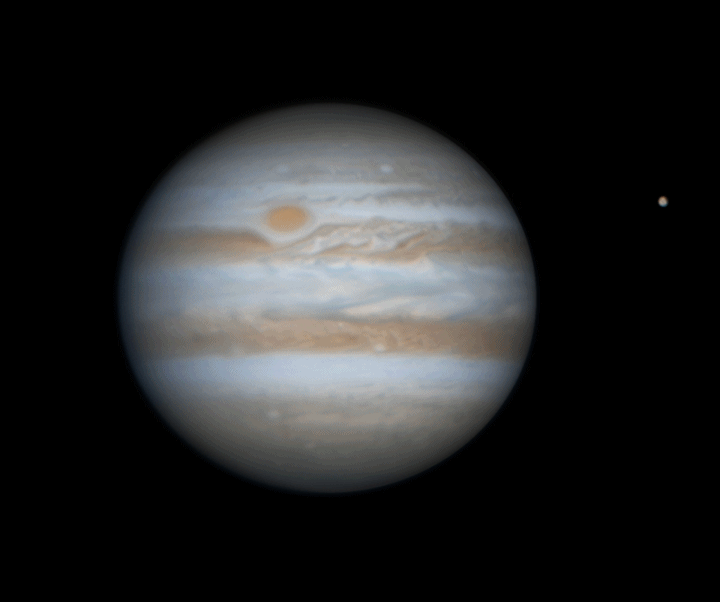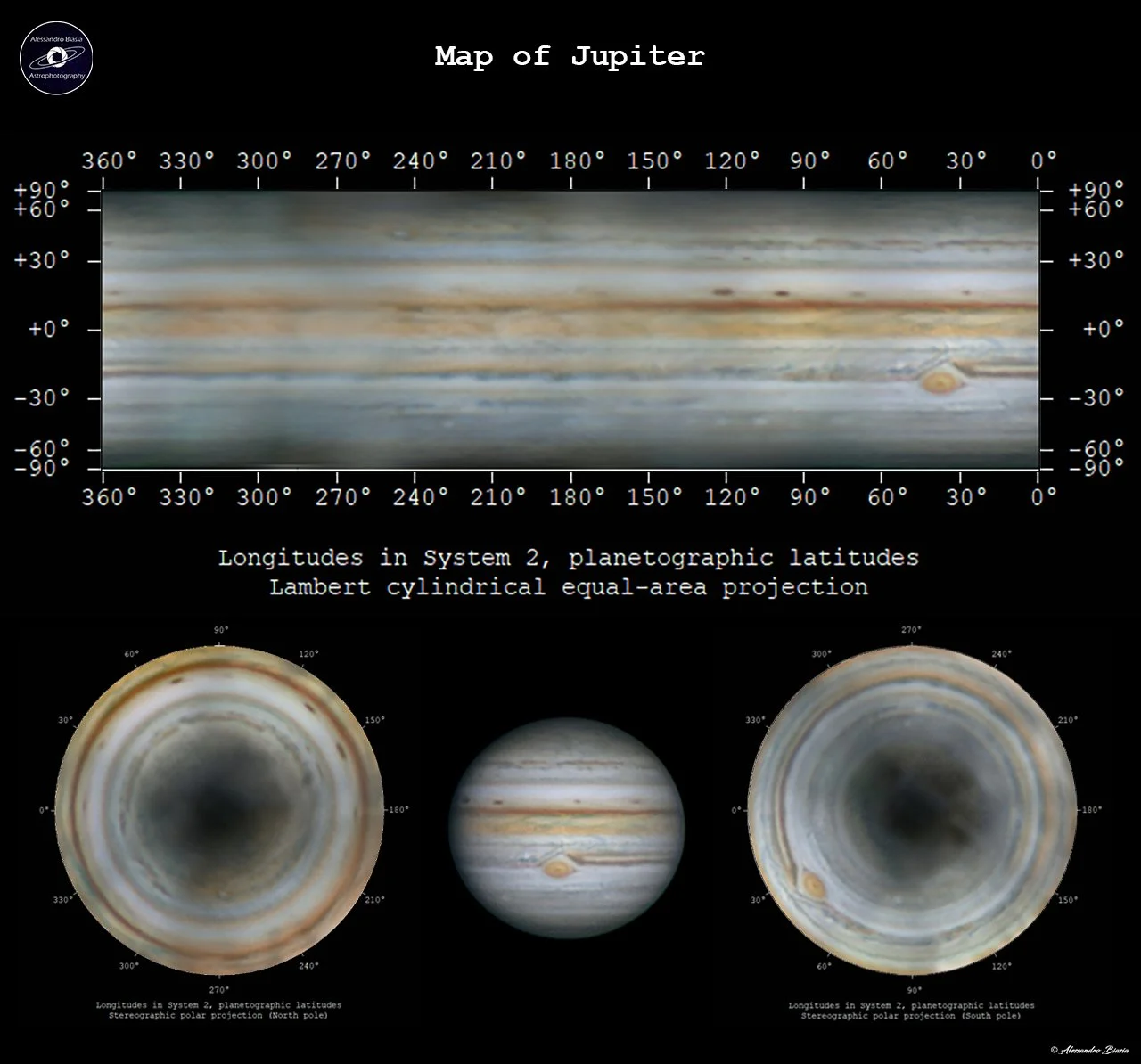
AAPOD2 Image Archives
jupiter
Featured Astrophotographer on AAPOD2
Jupiter rotation
Watching the planets rotate is always a captivating experience, but with Jupiter, it becomes truly spectacular. The largest planet in our Solar System completes a full rotation on its axis in just 10 hours, creating a mesmerizing display of motion. In this animation, we witness Jupiter's moon Europa passing in front of the gas giant, accompanied by the shadow it casts across the planet's swirling cloud tops. The striking 3D effect as Europa crosses Jupiter's face adds an incredible sense of depth and realism, making this celestial event even more awe-inspiring.
Jupiter, IO and GRS
Image Description and Details : A long awaiting window of good seeing finally transpired over my home observatory in Pembroke Pines, Florida early on Sunday morning July 3rd. The image is the result of 120 seconds capture at 13ms exposure, and stacked the best 46% of the frames. Europa and the Great Red Spot adding to the field of view. Hardware used: Celestron C11 Edge HD QHY 5-III 462c Camera ZWO Atmospheric Dispersion Corrector TeleVue 2.5 Powermate Primalucelab Eagle2 Pro Seeing conditions 4/5 Captured at 10:00 UT 07/03/2022 CM1=122.5 CM2=28.5 CM3=296.4 Earth distance at time of capture - 4.790 AU
Copyright: Varney Observatory
IMPACT on the planet Jupiter
Image Description and Details : IMPACT on the planet Jupiter
=========================
On 13.09.2021, I made a series of exposures to the transit of the IO satellite over the planet Jupiter.
Towards the end of the observation session, I noticed a large rapid spark in the IR filter, but I did not realize its importance until, the next day, the Brazilian amateur observer José Luis Pereira also discovered it in his captures and
he made it public. The seeing was good that night, but at the time of the impact it had dropped considerably.
Processing was required to combine the exposures made on the IR filter, in which the impact occurs, with the rest of the filters,
green and blue, to achieve a color image. The capture was made with a monochrome ZWO ASI 290MM camera, the exposure video being 2000 x3 frames on each filter.
The derotation of the SER videos was performed in the WinJUPOS program, the total duration being 14 minutes.
Although I am the beginning of the exposures to the planets, being focused on the deepsky pictures, I think I was very lucky to catch this event.
I want to thank Dm. astrophotographer Pepe Mera, for the tips related to the optical part, which have a lot in mind in the realization
exposures to planets.
Clear sky!
Telescope: Celestron Edge HD11
Camera: ZWO ASI 290MM
Fara Barlow
Filters: Optolong IR Pass 685nm filter
Astrodon G, B Gen2 E Tru-Balance filters
Frames: 2000x3x3 (28 fps)
Mount: EQ6R Pro
Processing: AutoStakkert, RegiStax, WinJUPOS, Photoshop
Details Jupiter:
Visual magnitude: -2.8
Diameter: 48.0 "
IO Satellite Diameter: 1,221 "(Visual Mag: 5.1 Mag)
Altitude: 24 °
Azimuth: 35 ° [SW]
Clear sky!
Cosmin Sandu
GAAP Group of Amateur and Professional Astrophotographers
Copyright: Sandu Val Cosmin
planetary tour
Grand tour of the outer planets from my backyard. Shot over the last 12 months with the fabulous Astro Physics 10" f/14.5 Mak-cass telescope and the QHY5III-462C color cmos camera. 37 degrees N. 100 ft el. Seeing can be very good at times.
Copyright: John Gleason
Transit from Ganymede
Image Description and Details :
Transit from Ganymede 25 July 2021
Average night conditions due to fine mist. The idea was to make a Gif of the Ganymede transit with at least 1 hour of duration, but due to fog the light conditions varied a lot, which would prevent having a homogeneous Gif.
Good thing Ganymede himself came out with good definition, note that especially in the image with the infrared filter the dark region of Edfu Facula at 2 am and the light region of Osiris at 6 am are perfectly distinguishable in the photo, which shows that they are not artifacts.
PS: The high resolution image of Ganymede was taken from the Virtual Planet Atlas.
Copyright: Astrovani
Jupiter's GRS rapid changes
Image Description and Details :
Jupiter can be even more dynamic in regions close to storms. Here we can observe the variation in the atmosphere close to GRS in an interval of only 3 days. The gas giant's best sighting season has just begun!
Celestron C8 @ f/20, ASI290, orhto 7mm, uv-ir cut
Copyright: Carlos Alberto Palhares
Solar System 2020
This is a collage of solar system objects Left to right: Mercury, Venus(in a very thin crescent phase), International Space Station, Mars, Jupiter, Saturn, Uranus, Wanning gibbous Moon on the top(19-panel mosaic), and Sun at the bottom(4-panel mosaic) all Captured in 2020 using Different equipment.
Equipment:
Telescopes: GSO 16" Dob on EQ platform, EdgeHD11", Esprit 80mmAPO
Cameras: ZWO462MC, ZWO 290MC, ZWO1600mmpro.
Accessories: ZWO UV/IR Cut filter, IR 685nm filter, ZWO ADC, Daystar quark Chromosphere, Tilt adaptor.
Software: Autostakkert!3, Registax, Photoshop
Location: Sharjah, UAE
Date: Jan - Dec 2020
Copyright: Prabhu S Kutti
Jupiter and Saturn Conjunction
Image Description and Details :
To obtain this picture, I assembled the results of two movies, one exposed for Saturn, and the other one exposed for Jupiter.
Technical details :- Orion 80ED refractor- Meade LXD55 mount- ZWO ASI 224 MC- Barlow Televue Powermate 2.5x- IRCut Baader filter- for each planets, 1000 pictures stacked with AutoStakkert v3, processing with Registax 6, photo assembly with Photoshop
Copyright Information: Christophe Gervier
Planetary Imaging 2020
Image Description and Details : The images have been acquired during the period February-October.For Jupiter and Saturn was a challenge since the planets were located about 26° above to the horizon.Setup used:C14 Edge HD Fornax52 mount ASI 178/290 mono Barlow Zeiss Baader filters RGB & IR>807nm IR>610nm UV320-380nm with ADC ZWO.
Copyright Information: Luigi Morrone
Jupiter Lum_IR_UV_CH4 Wavelengths Composite
Object Details:
Although I've been using various wavelengths for Deep Sky Objects (e.g. h-alpha, Oxygen III & Sulfur II), h-alpha for solar, and occasionally even 'narrowband' (e.g. DSO style) h-alpha filters for lunar and 'white-light' solar imaging (e.g. in an attempt to improve the seeing as longer wave-lengths tend to scatter less than shorter ones), I had not before tried any 'specialized' wavelength filters on the planets. Therefore, the attached composite is my first attempt to use such filters on Jupiter.
Starting with a 'normal visible' (luminance - IR/UV cutoff), from left the shots were taken using an Infrared, Ultraviolet, Methane and once again a Luminance filter. As is somewhat common, when utilizing 'specialized' filters, greyscale versions of each are included in the second row. Although Jupiter only reached an altitude of 26 degrees above our southern horizon and the seeing was fairly poor that evening, I was fortunate to catch the Great Red Spot while it was rotating on.
Generally speaking, when used on Jupiter the IR filter allows for greater penetration of the haze resulting in an enhanced contrast of small details; the UV enhances the cloud structures, while the methane (i.e. absorption) shows higher features in the Jovian atmosphere, with more methane appearing darker (and thus indicating lower) while little or no methane appears brighter (and thus indicates higher features in the atmosphere).
Image Details:
Taken by Jay Edwards at the HomCav Observatory on the morning of June 26, 2020. Being aware that the filters would attenuate the image, but not knowing to what degree, I kept the optical system used as 'photographically fast' as possible while still trying to maintain a reasonable focal length to provide some level of detail.
Therefore, the attached were shot at the prime focus of a (vintage 1970) 8-inch, f/7 Criterion newtonian reflector using an ASI290MC plaentary camera / autoguider. This scope is mounted on and tracked with a Losmandy G-11 running Gemini 2 control system.
Processed quickly using a combination of AS3, Reistax & PSP, given that these test shots turned out reasonably well, I'm looking forward to trying these filters again as we approach Jupiter's opposition next month, and if possible will add a barlow lens to increase the focal length / magnification.
Copyright: Jay Edwards
Solar System
Captured in a single day
Jupiter and Mars are in color with a 2xBarlow and Venus in UV and Mercury in IR in prime focus (2x enlarged).
Celestron 11" EdgeHD f/10 (f/20 for Mars & Jupiter) ASI290MC AVX mount
Copyright: Eric Sussenbach













